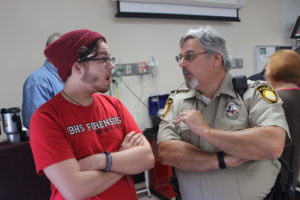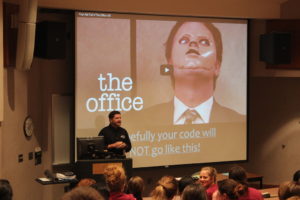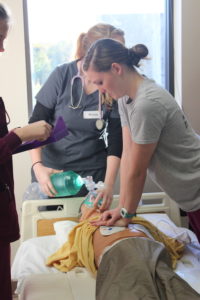
It was 8:30 a.m. As she sprinted up the stairs, Jody Settle, radiology senior, could only imagine what kind of crisis lie ahead of her. Reports of a patient who’d been in a bar fight were swarming across the hall. The crowded hospital floor was buzzing with angry patients and irritated medical staff. As she turned the corner, she faced a patient suffering a collapsed lung. But she had no time to think. He’d stopped breathing.
Except, only, he wasn’t real. The hospital floor was actually a classroom, and angry patients were just determined theater students.
On Nov. 18, the health sciences department hosted an Adult Code simulation that included departments from all corners of campus – respiratory, radiology, nursing, mass communication, and theater.
“It was very, very real,” Settle, one of the 122 health science students who participated in the simulation, said. “It really teaches you that communication is key, no matter what part of the process you’re responsible for. We went in there with a lot of mental preparation from our professors, but even then you’re really not prepared for that kind of situation. But, this kind of hands-on simulation is one of the most beneficial things we can do as students.”

Upon arriving to Bridwell 108, the students were briefed by Randy Case, assistant respiratory professor, and Jessyca Wagner, assistant radiology professor. Including a presentation complete with the infamous CPR dummy scene from “The Office,” Case and Wagner reassured their students of what to expect walking into the scenario. Breaking up the students into teams, the morning’s schedule was full for health science faculty, as well. Each session of the simulation, or “code” took place according to a schedule the supervisors had put together at their Nov. 8 meeting.
- 8:30 a.m. – Code 1
- 8:55 a.m. – Code 2
- 9:20 a.m. – Code 3
- 9:45 a.m. – Code 4
- 10:10 a.m. – Code 5
- 10:35 a.m. – Code 6
- 11:00 a.m. – Code 7
- 11:30 a.m. – Return to Bridwell 108. Debrief.
- 12:30 p.m. – Dismiss
“Overall, I was pleased with the way it went down,” Wagner said. “Everyone had their roles, knew what they were, and followed through, for the most part. From a professor’s perspective, we always want to know where students, where they’re comfortable, and what they can improve on. This scenario helped us do just that.”
Though professors were there to help their students when absolutely necessary, responsibility fell primarily to the students – a familiar sensation for students who have already begun the clinical portion of their education.
“You have to anticipate chaos. You won’t be able to focus if you’re not prepared for it,” Renetta Graham, respiratory senior, said. “I was intimidated, I won’t lie, but once I met up with my team, everyone was very helpful and very aware of what we all needed to do. When we go to clinicals, it’s not uncommon for the student to sort of get pushed aside in the high-intensity situations, so it was really nice to really get our hands dirty in a code like this.”
Though, health science students weren’t the only ones to “get their hands dirty,” as several theater students assisted them throughout the day by playing roles as doctors, patients, and irritable family members that kept health science students on their toes.
“It’s really exciting, getting to improvise roles like these,” Benton Fields, theater performance freshman, said. “I really love improv, so this is such a great experience. Not only do we get to help out the health science students, but we get to really delve into those skills that we don’t really get to perfect when we have a set script.”

To assist in creating the most realistic environment possible, the campus police even volunteered in handling overzealous patients and relatives. Keyvon Harrison, theater performance freshman, and one of five students who played a triage patient throughout the day, said he couldn’t have been happier to be a part of the code.
“It’s just so cool to see the different areas of education get together like this,” Harrison said. “We, as theater students, get to explore these full range of emotions as these terribly rude and inconsiderate emergency room patients, and the health science students get to practice saving a life. I mean, it’s a win-win.”
Mass communication students also played their role, covering the entire process as a documentary.
“Having an actual film crew was just a little shocking at first,” Obi Akammonn, nursing senior, said. “I mean, I wasn’t sure how real the simulation was going to be until I saw the waiting room, heard the noises, and then just saw this really professional-looking equipment moving around. It was a lot, but I would give anything to have more experiences like that in our curriculum.”
This was the second simulation event that the health sciences department has hosted since 2015. The first event, however, taught students how to address a similar situation with a small child, instead of an adult.














